-
Paper Information
- Previous Paper
- Paper Submission
-
Journal Information
- About This Journal
- Editorial Board
- Current Issue
- Archive
- Author Guidelines
- Contact Us
International Journal of Agriculture and Forestry
p-ISSN: 2165-882X e-ISSN: 2165-8846
2014; 4(2): 78-81
doi:10.5923/j.ijaf.20140402.05
Soil Components as Affected by Slope Condition and Slope Position in Alfonso Lista, Ifugao
Carmelito C. Valdez
Faculty, Ifugao State University (IFSU)-College of Agriculture and Forestry, Lamut, Ifugao 3605, Philippines
Correspondence to: Carmelito C. Valdez, Faculty, Ifugao State University (IFSU)-College of Agriculture and Forestry, Lamut, Ifugao 3605, Philippines.
| Email: |  |
Copyright © 2014 Scientific & Academic Publishing. All Rights Reserved.
This study aimed to assessed the level of the different soil nutrients particularly the Soil pH, Organic Matter (OM), Phosphorous (P) and Potassium (K) with the slope condition and slope position in the municipality of Alfonso Lista, Province of Ifugao. This study was conducted in the three Barangays of Alfonso Lista, Ifugao. The study site was selected and categorized according to slope condition such as below 18 %, 18 %-34 %, and greater than 34 %. Data were gathered based on the different slope position such as Lower slope, Mid-slope and Upper slope. The result of the study shows that soil pH, Organic Matter and Phosphorous in the different study site was observed to be higher in the lower slope while and Potassium was observed to be higher in upper slope. Comparing the three slope condition, Organic matter is observed to be higher in below 18 % compared to 18 % - 34 % and above 34 % while Potassium, Phosphorous and soil pH is marked higher in above 34 % in Slope. Condition of the soil is being affected by different factors such as slope, length of cultivation, conservation practices and others.
Keywords: Soil Condition, Soil Position, Soil Components
Cite this paper: Carmelito C. Valdez, Soil Components as Affected by Slope Condition and Slope Position in Alfonso Lista, Ifugao, International Journal of Agriculture and Forestry, Vol. 4 No. 2, 2014, pp. 78-81. doi: 10.5923/j.ijaf.20140402.05.
1. Introduction
- Ifugao province is part of the Cordillera Administrative Region (CAR) which is blessed with abundant natural resources and as such, it is aptly called the “watershed cradle of northern Luzon” (Ngohayon et al. 2010). However, the region is now confronted with an imbalance between the productive and protective uses of the watersheds. Socio-economic pressures have forced upland dwellers to farm extremely steep slopes, and even to the extent of converting forest lands to agricultural purposes. At the start of the new millennium, it was reported that illegal massive clearings of forest lands in some part of Ifugao province which became an extension farms which greatly affect the soil fertility in the upland by soil erosion and siltation of watershed tributaries which affects the quantity and quality of water.In the Philippines land degradation in the form of soil erosion and declining fertility is serious challenge to agricultural productivity and economic growth (FAO, 2007). Soil erosion by water is by far the greatest land degradation problem. Water erosion not only removes nutrients but also may reduce thickness and the volume of water storage and root expansion zone.Soil is an important component of the earth’s biosphere and is essential to sustaining the production of food and fiber and the maintenance of environmental quality. Inappropriate land use and poor soil management exacerbate soil degradation, adversely affect the environment, and jeopardize soil’s productivity (Philor 2011).Steep slope is one of the major causes of soil erosion in which the later causes the excessive loss of soil nutrient content, the reasons why soil fertility decline is the continuous cultivation (Amsalu and Graaff (2004). Soil erosion, insufficient of artificial nutrients, and moisture stress, absence of adequate input also results in deteriorating soil fertility and disturbs the soil structure thereby accelerating soil erosion. The mineralization process is also stronger in slope lands. Farming practices such as the long term use of nitrogen (N) increases soil pH (Edwards 1988).Weathering occurs at the mid – slope commune compared with hilltop commune and at the higher altitude, more organic matter and other nutrients are usually found in the foothill commune compared with the other two communes (Mulumba 2004).Knowing the soil nutrient content is very important for productive land utilization particularly on the species to be planted and amount of fertilizer to be supplied.ObjectivesGenerally, this study aims to assess the different soil essential nutrients of the selected sloping agricultural areas in Alfonso Lista, Ifugao. Specifically, this study has the following objectives: 1. Characterize the sloping agricultural lands in Alfonso Lista, Ifugao;2. Determine the level of nutrients (pH, OM, K & P) of the selected sloping agricultural lands in Alfonso Lista, Ifugao under various land condition;3. Comprehend soil components according to soil condition and Slope position.Materials and Methodology Soils samples were collected in the different study area and subjected into soil analysis at the Cagayan Valley Integrated Agricultural Research Center (CVIARC), Ilagan City, Isabela, Philippines to determine the pH, Organic matter (OM), Potassium (K), Phosphorous (P) level of each sampling site.The study sites were strategically chosen based on slope condition and slope position. Slope condition is based on the criteria (1) below 18 %, (2) 18 % - 34 % and (3) above 34 %. Considering sampling intensity and consistency soil samples were collected using the transect method in different position such as: (1) Lower slope, (2) mid-slope and (3) Upper slope. This study was conducted in three (3) Barangays of Alfonso Lista, Ifugao, Philippines namely; Namnama, Potia and Busilac.The data gathered (pH, OM, P & K ) was compared and analyzed using descriptive statistics.
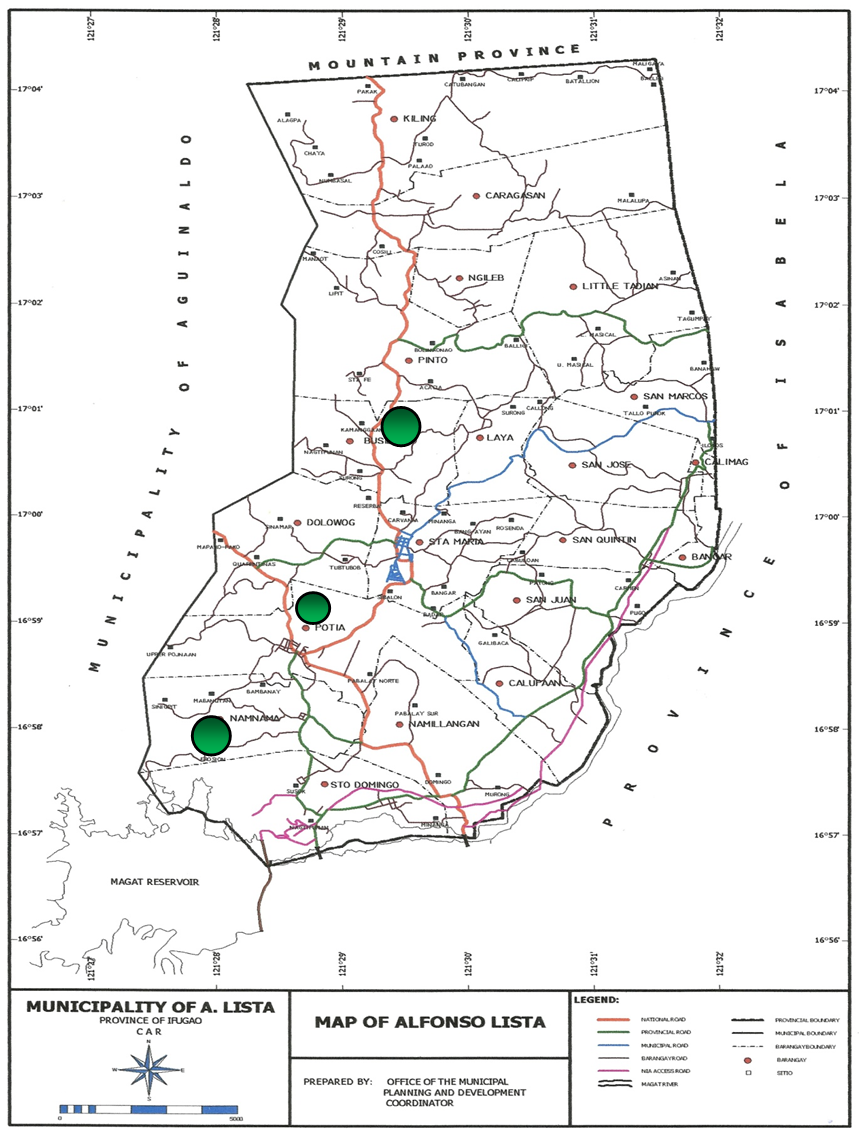 | Figure 1. Study Site |
2. Results and Discussion
- a. Accessibility of the study areasThe area is located on the northeastern part of Ifugao province. The entry point is in Ramon, Isabela using the national road 15-20 minutes travel.b. Crops Maize is being planted in the area for 2-3 cropping annually.c. Environmental Condition The climate of Alfonso Lista falls under the first climatic types. Type I, characterized by two pronounced seasons; dry from December to May and wet from June to November.The average annual rainfall in Alfonso Lista, Ifugao is 2037.7 millimeter. The months of September and October is expected to be the peak season for rainfall for it is expected to have rainfall intensity of about 208-240 millimeters. During summer (March and April) is expected to be the smallest amount of rainfall during the year round with a normal rainfall of only 27.6 millimeter (Figure 2).
 | Figure 2. Average annual rainfall (from PAGASA-Echague) |
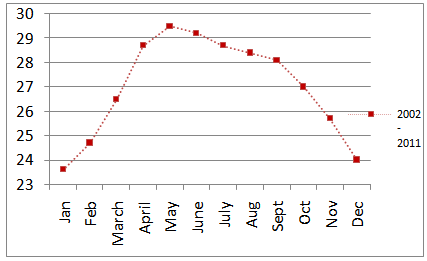 | Figure 3. Average Temperature (from PAGASA-Echague) |
 | Figure 4. Average pH, in Alfonso Lista, Ifugao, Philippines |
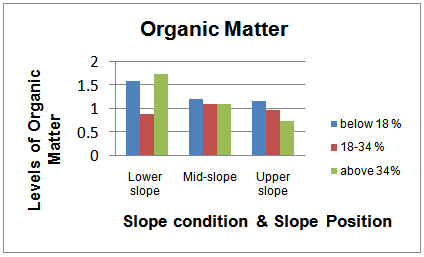 | Figure 5. Average organic Matter (OM in ppm) in Alfonso Lista, Ifugao |
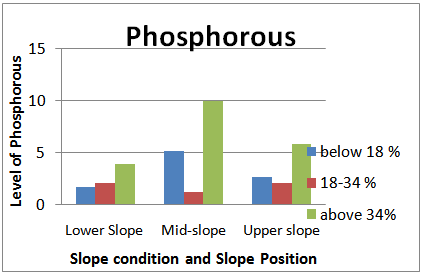 | Figure 6. Average Phosphorous (P in ppm), in Alfonso Lista, Ifugao |
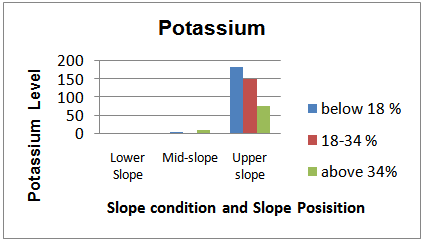 | Figure 7. Average Potassium (K in ppm), in Alfonso Lista, Ifugao |
3. Conclusions and Recommendations
- In general, the study found out that there is variation of levels of soil components (pH, OM, P, K) with regards to slope position and slope condition because agricultural practices and of soil erosion. The tendency is nutrients in the upper slope positions can be dissolved and washed by runoff and might be deposited in the middle and lower slope positions, due to steepness.It is recommended to practice cover cropping and contour plowing for slight to moderately sloping areas. Planting of perennial agricultural crops such as mango (Mangifera indica), Rambutan (Nephelium lappaceum) and Lansones (Lansium domesticum) on steep areas to minimize tillage by this practice soil erosion is reduced.
 Abstract
Abstract Reference
Reference Full-Text PDF
Full-Text PDF Full-text HTML
Full-text HTML